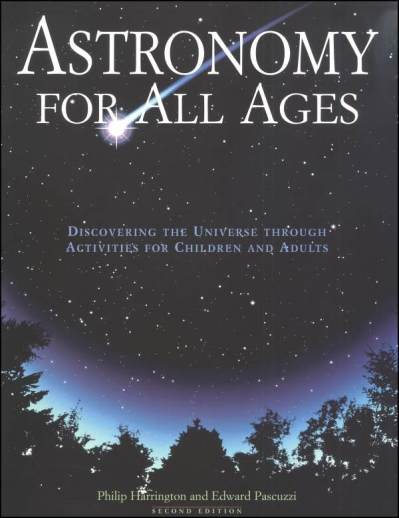We use cookies to make your experience better. To comply with the new e-Privacy directive, we need to ask for your consent to set the cookies. Learn more.
Astronomy for All Ages
For anyone interested in astronomy, this book provides a thorough, hands-on, extremely interesting and educational course. Rather than being just a wealth of information, it is presented through 51 different activities. Instead of just reading about it, students experience it, although they still get all of the quality information provided as background information to the activities. Charts, diagrams, and photographs complete the lessons and help present the concepts discussed in the text. The book is divided into six sections, each focusing on a different aspect of space. The first chapter begins with the naked-eye sky - activities and information about the night sky visible without the use of a telescope. Here students are introduced to the constellations found in the sky during the four different seasons, learning the names of the constellations, their placement at different times of the year, and some of the most well-known stars contained in them. After studying the charts of the night skies, the next activity directs students in constructing their own planispheres. Other activities cover star brightness, telling time, latitude, star sizes, artificial satellites, and light pollution. The next section focuses on the moon. Activities include learning the moon's phases, looking for lunar seas and craters, learning about the moon landing, and observing different cycles of the moon such as lunar crescents and eclipses. Section three revolves around the sun. Students will learn about the sun's period of rotation, the Northern Lights, sundials, analemmas, and solar eclipses through the activities in this chapter. Finally, students move on to the entire solar system. In this section they will learn about various planets, gravity, meteors, micrometeorites, comets, and ellipses, and they'll even get to build a pocket solar system. In the Deep Space section, students will be able to observe double stars, star clusters, nebulae, and galaxies. The last section delves into telescopes and photography, teaching students about optics, telescopes, cameras, and many of their astronomical capabilities. Here students will build their own reflecting telescopes and spectroscopes, as well as capture some pictures of the moon and star trails. The activities are clearly marked throughout the book to show age appropriateness, and adult assistance would be the most beneficial for the student. Working through the activities in the book could easily take an entire year, so this is a fairly serious course. The book contains several appendices, including a bibliography, listing of dealers of equipment, lunar phase dates, planet position, and astronomy web sites. Appropriate for even young children, this book is equally useful for adults interested in learning about the night sky. 214 pgs. - Melissa
| Product Format: | Softcover Book |
|---|---|
| Brand: | Globe Pequot Press |
| Grades: | PK-AD |
| ISBN: | 9780762708093 |
| Length in Inches: | 8.5 |
| Width in Inches: | 11 |
| Height in Inches: | 0.5 |
| Weight in Pounds: | 1.0625 |

